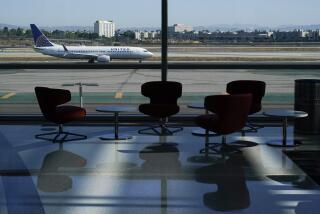LAX Theme Building Was Drawn as Hub of Jet Age’s ‘First Airport’
“What is the theme?”
That’s the existential question that haunts the Theme Building at Los Angeles International Airport.
Waitresses scooting around the saucer-shaped restaurant atop this web of spindly arches give answers that range from the Zen-like (“it’s its own theme”) to the mundane (“flight, of course”). The Theme building hovers between the two, evoking vague images of the Jetson’s zipping through the galaxies as it spins an abstract web of geometric perfection around the center of the airport.
You can see it from almost anywhere near the airport, but few of the 50 million passengers a year who circulate around its base ever enter it. It is a marker that creates a recognizable, optimistic image at the heart of the formless mess of the airport.
When I first landed at LAX, I thought the Theme Building was the control tower. Indeed, that was the original intent of architect William Pereira, who designed LAX between 1955 and 1962 as “the first airport of the Jet Age.” Rising up at the middle of the horseshoe-shaped airport, the tower was meant to be control central, a glass-and-steel command post sending out its arches into the terminals.
The whole scheme for LAX was futuristic: all parking was to be underground, leaving only glass bubbles sticking up above ground to greet the jets lumbering down the otherwise open Tarmac. The bubbles would house the arrival and departure lounges.
The theme of glass domes and long ramps was buried during the 10-year design process by the realities of economy and the ever-expanding size of both terminals and airplanes.
When the fanciful centerpiece of the composition was finally erected in 1962, the control tower had been built separately, leaving the controlling icon of the Theme Building as a remnant of a whole system of architecture that was meant to sum up the optimistic, technological wizardry of modern flight.
Though the building is nothing but a series of overlaid circles in the plans, when you see it from any angle except overhead, it appears like an ever-changing piece of sculpture. The support offered by the arches is only visual, as the saucer-shaped restaurant actually rests on a blue-tiled column that contains all the services. The stucco parabolas that are the arches look as though they tether a restaurant that wants to fly with all the planes around it.
The exuberance of the large scale is unfortunately lost close-up, where the arches dive into beds of posies and the bland detailing that seems to curse most structures built in the early 1960s brings you back to the ground.
“The flying saucer doesn’t even turn,” architect Charles Moore once lamented. Once inside the static restaurant (the public Observation Post is currently closed due to tightened security), you get a majestic view over the whirl of airport activity. From high atop the marooned spaceship, you get a sense of the ceaseless, sometimes miraculous motion that inspired Pereira to imagine an architecture beyond the bounds of gravity.
Theme Building, Los Angeles International Airport
Year constructed: 1962
Architect: William Pereira
Hours: Restaurant open every day, 11 a.m.-10 p.m.
Information: (213) 646-5471
More to Read
The biggest entertainment stories
Get our big stories about Hollywood, film, television, music, arts, culture and more right in your inbox as soon as they publish.
You may occasionally receive promotional content from the Los Angeles Times.










